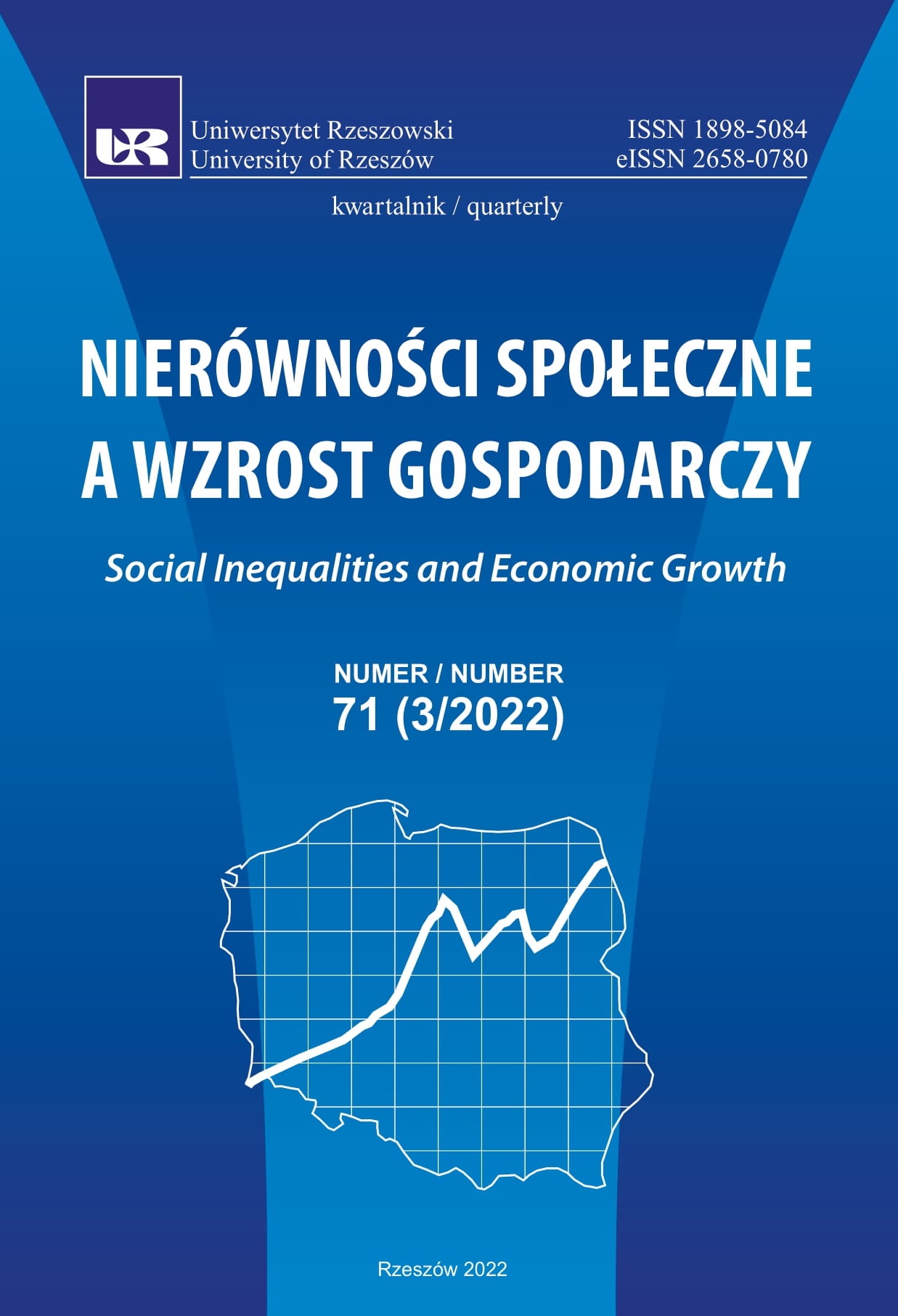Politics, growth and inequalities in China since 1949. An assessment attempt
DOI:
https://doi.org/10.15584/nsawg.2022.3.3Keywords:
China, Chinese economy, economic reforms, economic transitionAbstract
The aim of the article is to examine and present the policies, processes and effects of economic growth in China since 1949, i.e. the establishment of the People’s Republic of China. Two research questions were formulated on this basis: how the processes of economic growth and development progressed in Mao Zadong’s times, and how the reforms during the Deng Xiaoping period influenced the economy of modern China. A historical analysis based on domestic and foreign literature is mainly used in the paper, as well as an analysis of existing data. Based on the conducted research, it can be concluded that the economic policy in the Maoist era, despite all its flaws and defects, made a huge contribution to the development of China, leading, inter alia, to reducing illiteracy and extreme poverty. Finally, the policy supplemented by more efficient market mechanisms led to the true prosperity of this country. Nevertheless, it is impossible not to notice the problems that are growing and in the next few years may become a barrier to further growth: high inequalities, an ageing population, and environmental issues. Given China’s ability to adapt and solve problems, we may hope that they will also resolve these problems. The challenges China is facing are serious, nevertheless, taking into account the way they have overcome, it can be hoped that the current problems will also be resolved.
Downloads
References
Białowąs, T. (2007). Przestrzenne zróżnicowanie poziomu rozwoju gospodarczego Chin. Annales Universitatis Mariae Curie-Skłodowska. Sectio H, XLI, 2, 33–46.
Chan, K.W. (2019). China’s Hukou System at 60: Continuity and Reform. W: R. Yep, J. Wang, T. Johnson (red.), Edward Elgar Handbook on Urban Development in China (s. 59–79). Cheltenham: Edward Elgar Publishing. DOI: 10.4337/9781786431639.00011.
Chao, K. (1964). Economic Aftermath of the Great Leap in Communist China. Asian Survey, 4, 5, 852. DOI: 10.2307/3023479.
Cheng, E. (2021). China scraps fines, will let families have as many children as they’d like. Pobrane z: https://www.cnbc.com/2021/07/21/china-scraps-fines-for-families-violating-childbirth-limits.html (2022.06.25).
Cieślik, E. (2015). Rozwój gospodarczy Chin. Warszawa: Key Text.
Cieślik, E. (2017). Rozwój gospodarki chińskiej w okresie realnego socjalizmu – analiza podstawowych wskaźników. Gdańskie Studia Azji Wschodniej, 11, 59–82.
Dikötter, F. (2013). Wielki głód. Tragiczne skutki polityki Mao 1958–1962. Wołowiec: Czarne.
Fuchun, L. (1962). Report of the First Five-Year Plan. W: R.R. Bowie, J.K. Fairbank (red.), Communist China (s. 42–91). Cambridge: Cambridge University Press.
Gawlikowski, K. (2004). Procesy transformacji w Chińskiej Republice Ludowej. W: K. Gawlikowski (red.), Azja Wschodnia na przełomie XX i XXI wieku. Przemiany polityczne i społeczne (s. 81–147). Warszawa: Wydawnictwo TRIO.
Góralczyk, B. (2017). Geostrategia Xi Jinpinga – od skromności do globalnej asertywności. Gdańskie Studia Azji Wschodniej, 11, 26–50.
Góralczyk, B. (2018). Wielki renesans. Chińska transformacja i jej konsekwencje. Warszawa: Dialog.
Groves, T., Hong, Y., McMillan, J., Naughton, B. (1994). Autonomy and Incentives in Chinese State Enterprises. Quarterly Journal of Economics, 109(1), 183–209. DOI: 10.2307/2118432.
Hay, D., Morris, D., Liu, G., Yao, S. (1994). Economic Reform and State-Owned Enterprises in China 1979–1989. Oxford: Clarendon Press.
Historical National Accounts of the People’s Republic of China, 1952–1995. Pobrane z: https://www.ier.hit-u.ac.jp/COE/Japanese/online_data/china/china.htm (2022.06.13).
How Well-off is China’s Middle Class? Pobrane z: https://chinapower.csis.org/china-middle-class/ (2022.06.30).
Jefferson, G.H., Rawski, T.G. (1994). Enterprise Reform in Chinese Industry. Journal of Economic Perspectives, 8(2), 47–70. DOI: 10.1257/jep.8.2.47.
Johnson, D.G. (1988). Economic Reforms in the People’s Republic of China. Economic Development and Cultural Change, 36(S3), 225–245. DOI: 10.1086/edcc.36.s3.1566544.
Joseph, W.A. (1986). A Tragedy of Good Intentions: Post-Mao Views of the Great Leap Forward. Modern China, 12, 4, 419–457. DOI: 10.1177/009770048601200401.
Kleer, J., Perczyński, M., Dobosiewicz, Z. (1989). Z doświadczeń rozwoju skokowego. Warszawa: PWE.
Kowalik, T. (2005). Systemy gospodarcze. Efekty i defekty reform i zmian ustrojowych. Warszawa: Fundacja Innowacja.
Lardy, N.R. (1987). Economic recovery and the 1st Five-Year Plan. W: R. MacFarquhar, J.K. Fairbank (red.), The Cambridge History of China. Volume 14: The People’s Republic, Part 1: The Emergence of Revolutionary China 1949–1965 (s. 144–184). Cambridge: Cambridge University Press. DOI: 10.1017/CHOL9780521243360.004.
Li, W., Yang, D.T. (2005). Great Leap Forward: Anathomy of a Central Planning Disaster. Journal of Political Economy, 113(4), 840–877. DOI: 10.1086/430804.
Lin, J.Y. (1988). The Household Responsibility System in China’s Agricultural Reform: A Theoretical and Empirical Study. Economic Development and Cultural Change, 36(S3), 199–224. DOI: 10.1086/edcc.36.s3.1566543.
Maddison, A. (2007). Chinese Economic Performance in the Long Run. Second Edition, Revised and updated. Pobrane z: http://piketty.pse.ens.fr/files/Maddison07.pdf (2022.06.20).
National Bureau of Statistics of China. Pobrane z: http://www.stats.gov.cn/english/statisticaldata/yearlydata/ (2022.06.12).
Naughton, B. (1993). Deng Xiaoping: The Economist. The China Quarterly, 135, 491– 514. DOI: 10.1017/S0305741000013886.
Perkins, D. (1994). Completing China’s Move to the Market. Journal of Economic Perspectives, 8(2), 23–46. DOI: 10.1257/jep.8.2.23.
Stuart-Fox, M. (2003). A Short History of China and Southeast Asia: Tribute, Trade and Influence. Crows Nest: Allen & Ulwin.
Szymański, W. (2007). Czy globalizacja musi być irracjonalna? Warszawa: Oficyna Wydawnicza SGH.
Whyte, M.K. (2010). Myth of the Social Volcano. Perceptions of Inequality and Distributive Injustice in Contemporary China. Stanford: Stanford University Press.
Whyte, M.K. (2012). China’s Post-Socialist Inequality. Current History, 111(746), 229–234.
Więckowski, H. (2014). Polityka jednego dziecka i jej wpływ na strukturę demograficzną Chińskiej Republiki Ludowej. Zarządzanie Publiczne, 1(25), 51–62. DOI: 10.4467/20843968ZP.14.005.2178.
World Bank Database. Pobrane z: https://data.worldbank.org/ (2022.06.22).
World Inequality Database. Pobrane z: https://wid.world/data/ (2022.06.22).
Worden, R.L., Savada, A.M., Dolan, R.E. (1987). China: A Country Study. Washington: GPO for the Library of Congress.
Yang, D. (1999). Urban-Biased Policies and Rising Income Inequality in China. American Economic Review (Paper and Proceedings), 89(2), 306–310. DOI: 10.1257/aer.89.2.306.
Yao, S. (1994). Agricultural Reforms and Grain Production in China. London: Macmillan Press. DOI: 10.1007/978-1-349-23553-7.
Yao, S. (1997). Profit Sharing, Bonus Payment, and Productivity: A Case Study of Chinese State-Owned Enterprises. Journal of Comparative Economics, 24(3), 281–296. DOI: 10.1006/jcec.1997.1435.
Downloads
Published
How to Cite
Issue
Section
License
Copyright (c) 2022 University of Rzeszow

This work is licensed under a Creative Commons Attribution-ShareAlike 4.0 International License.


